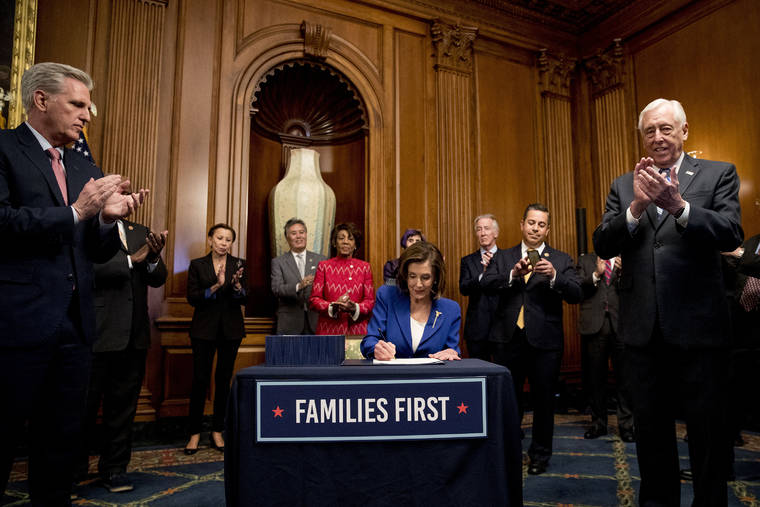Editorial: Help is on the way for many left jobless, struggling — but know how to access it

ASSOCIATED PRESS
House Speaker Nancy Pelosi of Calif., accompanied by House Minority Leader Kevin McCarthy of Calif., left, House Majority Leader Steny Hoyer of Md., right, and other bipartisan legislators, signs the Coronavirus Aid, Relief, and Economic Security (CARES) Act after it passed in the House on Capitol Hill, Friday.
America is deep in survival mode, racing to save itself from a spreading disease — and to salvage its battered economy. If there is anything to celebrate in the midst of this horrific coronavirus Opens in a new tabpandemic Opens in a new tab, it is that a moribund Congress, rife with partisan obstructions, has managed to act in the interest of the nation, and in relatively short order.
The Coronavirus Aid, Relief, and Economic Security (CARES) Act, finalized on Friday with a signature from President Donald Trump, is an immense, $2 trillion rescue package that, if implemented well through a collaboration of government and community leaders, should provide some lift for an economic relaunch, once the health threat has abated.
At the moment, though, that remains only the hope — nobody really knows how and when the coronavirus invasion will retreat — but at least it provides some focus for how leadership should move ahead.
It is incomparably massive. In the unemployment-benefit arena especially, it’s generous, extending to more beneficiaries, and with an additional $600 put in the checks. But that level of outlay matches the scale of this unprecedented global calamity.
In the U.S., jobless claims had gone from a historic low of 200,000 to 3.3 million within three weeks. That’s simply stunning, and the landscape already has become even more bleak as more people finally got through the crashed websites and added to the mountain of claims.
And Hawaii has felt it acutely, its relatively low number of confirmed coronavirus cases notwithstanding. Due to the state’s dependence on the devastated travel industry, the trickle-down effect has been more of a debilitating flood of job losses and unemployment claims, a tide that continues to rise.
Don't miss out on what's happening!
Stay in touch with breaking news, as it happens, conveniently in your email inbox. It's FREE!
Having some financial relief will be a help, but it’s still unclear how the money will come through, or which needs may or may not be met. A major priority for Hawaii’s congressional delegation and, more critically, its business and social-service networks, must be to stay on top of the rules developed for the programs and guide their constituents in how to claim them.
Some of the funding streams are fairly straightforward, including the direct payments allotted to all Americans. The checks to go out will amount to $1,200 per adult and $500 per child, with a reduction in the amount phasing in above the $75,000 individual annual income level.
This is meant as stimulus that will be most effective at the lower-to-moderate income households that will be most likely to spend the money, enabling rent to be paid and cash to trickle down. It makes sense. The U.S. is primarily a consumer economy, and when cash is in short supply, such a kick-start becomes critical.
But there are complexities in the plan’s programs, and there is a need for clarity, said Hawaii’s U.S. Sen. Brian Schatz.
For example, Hawaii’s small businesses will receive a share of the $377 billion available for businesses with 500 employees or fewer. It’s a new program, he said, unusual in that the money is issued as loans, but repayment can be waived if records are strictly kept and rules are followed.
This is something that elected leaders, as well as nonprofit advocates such as the Chamber of Commerce Hawaii, will have to track carefully and reach out to businesses, ensuring that, as Schatz said, “this is actually available, not just theoretically available.”
Similarly, in the social-service arena, there are questions about how workers in the “gig economy” — the self-employed and freelancers who have few formal protections — will compute their claims for unemployment funds, as the new rescue package enables them to do. And provisions for student loan relief and rent and mortgage forbearance will become clearer only after the dust has settled.
All that uncertainty aside, there is at least a mechanism for independent oversight, a measure of safety that was insufficient in the recovery programs a decade ago, after the financial meltdown of 2008. The new law creates the Pandemic Response Accountability Committee, a panel of inspectors general from various agencies to conduct investigations and audits. That’s a start.
And the asking and answering of questions has already begun. Hawaii U.S. Rep. Ed Case has a breakdown of the benefit programs on his website: Go to case.house.gov/coronavirus Opens in a new tab and scroll down for some CARES Act information.
It’s plain that there are more varied components to this effort than has ever been assembled for a nation in trouble, and that’s critical. Never before has every sector of the economy and elements of the safety net been hit so hard.
One is a needed reinvestment in the health-care system equipment and infrastructure. Rescue funds for the airline industry is also part of the act — essential to the U.S. as a whole, and a lifesaver to Hawaii.
Nobody can know what’s ahead in these unprecedented times, but help is on the way. There is at least comfort to be drawn simply in knowing that.




